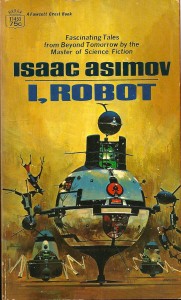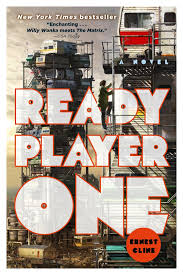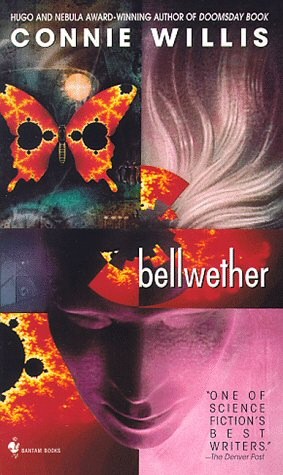
Since it is the start of a new year, I thought readers might enjoy some reading recommendations for this year, namely science fiction (SF, sometimes generalized to speculative fiction) books that contain themes of special interest to computer scientists.
At the annual SIGCSE conference last March, there was a Birds of a Feather (BOF) group titled “Using Science Fiction in CS Courses“, organized by Rebecca Bates, Judy Goldsmith, Valerie Summit, and Nanette Veilleux. I unfortunately had a conflict that prevented me from attending this BOF, but as an avid reader, I was interesting in hearing what had transpired, and Ariel Ortiz Ramirez was kind enough to provide an overview of the session for me – thank you!
One of the outcomes from this BOF was a list of three books they recommended SIGCSE attendees read over the next year. (I think the idea may have been that people like me who are conversationally challenged would have something we could talk about at this coming year’s conference!) I had read two of the three before, but I decided to reread them all. I recently finished the third book, so I thought I would share the group’s list for others to enjoy.
1. I, Robot, by Isaac Asimov (1950).
 In this SF classic, Asimov’s central character is Dr. Susan Calvin, a senior, future roboticist who is being interviewed about the history of robotics. Her recollections form nine short stories that explore different aspects of human-robot interactions. One of the stories (Runaround) is where Asimov first enumerated his famous Three Laws of Robotics:
In this SF classic, Asimov’s central character is Dr. Susan Calvin, a senior, future roboticist who is being interviewed about the history of robotics. Her recollections form nine short stories that explore different aspects of human-robot interactions. One of the stories (Runaround) is where Asimov first enumerated his famous Three Laws of Robotics:
1. A robot may not injure a human being or, through inaction, allow a human being to come to harm.
2. A robot must obey orders given to it by a human being, except where such orders would conflict with the First Law.
3. A robot must protect its own existence, as long as such protection does not conflict with the First or Second Law.
Most of the stories are based on situations in which these laws cause robots to behave in surprising and unexpected ways. Several of the stories feature recurring characters, and the interview with Dr. Calvin serves as a wrapper that organizes the individual stories into a speculative history of robotic development, as imagined by Asimov.
Several of the stories are mysteries, and many of them deal with issues of ethics and/or morality, making this book an engaging discussion starter for exploring the social and ethical issues of computing, and unintended consequences of technology for society.
It is worth mentioning that I, Robot the book and I, Robot the film are only tangentially related. I, Robot the film is very loosely based on just one of these nine stories (Little Lost Robot). The film incorporates Asimov’s Three Laws and the names of some of his characters (including Dr. Calvin), but its plot differs markedly from Little Lost Robot, and it is unrelated to the other stories in the book. Put differently, if you have seen the movie, the book is almost entirely different, and very much worth reading.
2. Ready Player One, by Ernest Cline (2011).
 I had never heard of this book before the SIGCSE group recommended it, and when I learned that it was (a) the author’s debut novel, and (b) a “young adult” book, I was pretty skeptical. Much to my surprise, I found it very entertaining and enjoyable to read, and I am now looking forward to reading more of Mr. Cline’s work.
I had never heard of this book before the SIGCSE group recommended it, and when I learned that it was (a) the author’s debut novel, and (b) a “young adult” book, I was pretty skeptical. Much to my surprise, I found it very entertaining and enjoyable to read, and I am now looking forward to reading more of Mr. Cline’s work.
This book is set in a grim dystopian future in which people escape from reality in a free-to-all massive multiplayer virtual reality called OASIS. (Imagine something like Second Life on steroids.) The creator of OASIS has died, leaving a will in which he announced that his quarter-trillion dollar fortune and ownership of OASIS are to be awarded to the person who finds an Easter egg he has hidden inside OASIS. The Egg is hidden behind three gates, which can only be unlocked by three keys, which are also hidden in OASIS. This announcement set off a frenzied treasure hunt for the keys, initially by individual gamers. One of these gamers is Wade Watts, the book’s teenaged protagonist.
At the book’s outset, five years have elapsed and no one has found any of the three keys. With such a large prize at stake, venture capitalists have formed a corporation known as IOI who want to find the Egg and turn OASIS into a more exclusive pay-to-play venture. To find the Egg, they hire an army of gamers, researchers, and anyone else they think might help them solve the puzzle. The story is Wade Watts and his (male and female) friends racing against IOI to find the hidden keys and the Egg.
The 1980s were the formative years of the creator of OASIS, and it is known that he collected 80s cultural artifacts, so many believe that the 1980s hold the key to solving the puzzle. The plot takes many twists and turns, and the book is loaded with references to 1980s technical culture (e.g., arcade games, Dungeons & Dragons, Monty Python, early video games, …) that, combined with its dystopian setting made it unusually entertaining. As you might guess, computing and gaming play major roles in the story, so this is a fun, easy book to read and discuss with anyone interested in gaming, graphics, and/or virtual reality.
3. Bellwether, by Connie Willis (1996).
 Connie Willis is an excellent and experienced writer, having won more major SF writing awards (i.e., Hugo, Nebula, etc.) than any other author, living or dead. While many of her books deal with time travel to historically interesting times, Bellwether is a screwball comedy in which she relates chaos theory to people’s propensities to follow fads.
Connie Willis is an excellent and experienced writer, having won more major SF writing awards (i.e., Hugo, Nebula, etc.) than any other author, living or dead. While many of her books deal with time travel to historically interesting times, Bellwether is a screwball comedy in which she relates chaos theory to people’s propensities to follow fads.
The book’s main character is Dr. Sandra Foster, a sociologist who is one of many researchers at Hi-Tech, a research-oriented think-tank. Hi-Tech is funding her research on fads, hoping that it will allow them to predict (and capitalize on) fads. Because of a mis-delivered package, Dr. Foster meets an expert on chaos theory who is seemingly immune to fads, making him a person of interest for her research. Through a tangled series of events, the two eventually combine their research into a joint interdisciplinary project involving a flock of sheep. Throughout the book, Hi-Tech’s “Director of Communications” spreads chaos wherever she goes, which eventually leads Dr. Foster to an insight that brings her research and the book to a satisfying conclusion.
The book is full of ironic and sarcastic humor, which makes it an entertaining read. For example, as Dr. Foster is researching older fads and identifying new ones, Hi-Tech’s administrators keep summoning her and her peers to meetings in order to inflict new management fads on them. Willis also begins each chapter with a humorous overview of some historical fad, ranging from hula hoops to the Macarena.
Computing plays only a supporting role in the story, but chaos, strange attractors, randomness, serendipity, and scientific research all play important roles. For this reason, Bellwether could provide good recreational reading for anyone interested in chaos theory, research, or seeing how a skilled author can mix comedy, romance, and science, all within the same story.
* * *
Those are the three books that the BOF at SIGCSE recommended. Their choices got me to thinking,
“If I were recommending SF books for computer scientists to read – books in which computing technology plays a pivotal and thought-provoking role – what would those books be?”
I will reveal my recommendations in a month or two, but I’d like to hear your thoughts first. What book(s) would you recommend?



Join the Discussion (0)
Become a Member or Sign In to Post a Comment